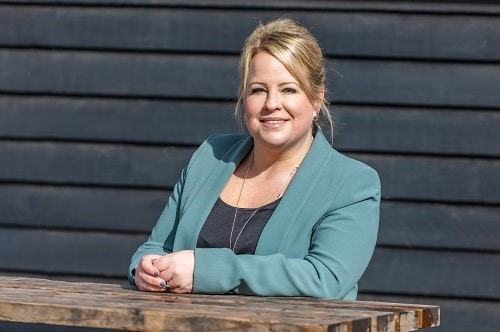As a survivor of domestic abuse, I know first-hand the importance of employers creating a workplace environment where employees feel able to disclose they are experiencing abuse – and offering suitable support and guidance.
Features
Domestic abuse: why it IS your business
The winter nights have set in and most of us wrap up our working day after the sun has set; some of us leave the hustle and bustle of an office block and escape to the warmth of our houses, while others close the lid of their laptop and retire downstairs to their families and a softly lit, warm, living room. For another 2.4 million of us the warmth of a loving home does not come, for 2.4 million of us the darkness and cold linger, 2.4 million of us are silenced, suffering and broken. Because 2.4 million of us are victims of domestic abuse. Harmed, beaten and manipulated by the people we love and trust.
 Sharon Livermore: "Work was my safe place, but nobody questioned my perpetrator turning up unannounced or the relentless phone calls he made to my office."
Sharon Livermore: "Work was my safe place, but nobody questioned my perpetrator turning up unannounced or the relentless phone calls he made to my office."
My story
I was silenced, suffering, and broken. Today I am not silenced, I no longer suffer, and I am far from broken. I am a survivor of domestic abuse; but on a dark November night in 2015, I left the warmth of my office, waved goodbye to a colleague, and climbed into my car. The lingering smell of aftershave and a steamy car window saved my life. In the days leading up to 4th November 2015, my perpetrator, and then husband, carefully orchestrated how he would kidnap and murder me, this was to be his final act to end 20 months of physical and emotional abuse.
As I got into my vehicle, I had a sense of foreboding, suddenly imagining my perpetrator behind me. But when I spun around, there was nobody there. I had noticed that the car windows were steaming up, which was odd. As I sat in the car, I smelt my abuser’s aftershave. Instinct propelled me to check under my car seat, where I found a picnic blanket that was normally left in the boot. I got out of the car and opened the boot, and found my abuser there, waiting with a knife and cable ties. I ran, and he came after me.
Thanks to the intervention of a work colleague, I was able to escape from my perpetrator that evening, though he fled the scene in my car. He was subsequently arrested and jailed for attempted kidnapping. The police and prosecutors said they were certain he wanted to murder me, but they could not prove it beyond a reasonable doubt. He spent two days planning his actions. At no point did he stop and think about the lasting impact of his actions.
 It takes a victim (on average) seven attempts to leave a relationship before they leave for good. Photograph: iStock
It takes a victim (on average) seven attempts to leave a relationship before they leave for good. Photograph: iStock
Before we got married, this man was my 'knight in shining armour'. However, after we got married my life changed dramatically. I was subjected to relentless coercive and controlling behaviour, as well as emotional and physical abuse. I was gradually forced to isolate from friends and family, not allowed to talk or reach out to anyone. I was spoken of as a dynamic, intelligent and successful woman, but my life was shrinking, becoming smaller and smaller over time.
Are you wondering why I didn’t leave? The answer is straightforward: it is incredibly dangerous. In 2018, a staggering 41 per cent of women in the UK who were killed by a partner or former partner had either separated from or initiated the process of separating from the perpetrator.
Work was my safe place, but nobody questioned my perpetrator turning up unannounced or the relentless phone calls he made to my office. This is common as 75 per cent of domestic abuse victims are targeted in the workplace and a further 40 per cent of victims are prevented from going to work by their abuser.
I suffered from severe anxiety and found this would peak at the end of the working day when a phone call came in because I was expected home at 6pm on the dot. A minute after 6pm and I would face interrogation and he would use my ‘lateness’ as a catalyst for abuse. An educated employer may have spotted the irrational and unexplained behaviours I displayed, and employers who are trained would also know how to sensitively raise any concerns they may have had. This may have included advising me not to leave the abusive relationship until I could do so safely.
A few days prior to the attempted kidnapping I found a final thread of strength, a strength so many never find, to raise my voice and seek support from my employer. It is important to note here that I may have come forward earlier had my employer, at the time, been properly educated and adequately equipped to handle domestic abuse cases. However, research shows that only five per cent of organisations have specific policies or guidelines in place for domestic abuse.
Stigma around domestic abuse
Despite this low statistic we at Domestic Abuse Education have noticed that an increasing number of businesses are beginning to recognise the importance of addressing domestic abuse in the workplace – although the topic is still heavily stigmatised. The stigma surrounding domestic abuse originates from ignorance, and like many stigmas, researchers suggest that it arises from fictitious beliefs, both conscious and unconscious, that individuals hold about domestic abuse and
its survivors.
Dispelling the myths associated with domestic abuse is a significant aspect of my campaign against domestic abuse and the training I provide to managers, team leaders and employees on improving domestic abuse awareness and support in the workplace. This commitment extends beyond the efforts of my organisation Domestic Abuse Education and is seen through the everyday and long-standing work of many other organisations, including the Employers’ Initiative on Domestic Abuse (EIDA) and Surviving Economic Abuse.
 The stigma surrounding domestic abuse may arise from fictitious beliefs that individuals hold about domestic abuse and its survivors. Photograph: iStock
The stigma surrounding domestic abuse may arise from fictitious beliefs that individuals hold about domestic abuse and its survivors. Photograph: iStock
I believe all three organisations, and many others, provide invaluable resources and support for employers aiming to deepen their understanding of how to effectively support employees who are subject to domestic abuse.
Addressing and challenging the myths surrounding domestic abuse not only aligns with my advocacy but also reflects a broader trend among businesses that are committed to increasing their domestic abuse knowledge and creating supportive environments.
Some of the myths associated to domestic abuse include:
- It is not our business
- If it were that bad, they would leave. On the contrary, it takes a victim (on average) seven attempts to leave a relationship before they leave for good
- It only happens to those who are financially destitute.
Therefore, the onus is on businesses to get educated – and educate their staff – about domestic abuse to break the stigma and associated misconceptions around the problem. This is the only way we can eliminate these harmful myths, some of which prevent a victim leaving their abuser and seeking support.
By taking proactive steps to spot the signs of domestic abuse, providing support to staff and facilitating access to external resources, businesses will encourage a safer and more supportive work environment.
Benefits of taking action
For employees, the benefits are profound. Recognising and addressing domestic abuse in the workplace can create a culture of empathy and understanding, allowing victims to feel supported and less isolated. Providing a safe space for disclosure and intervention can empower individuals to seek help and break free from the cycle of abuse. This, in turn, can lead to improved mental health, increased job satisfaction and enhanced overall productivity.
Employers also stand to gain significantly from implementing measures to address domestic abuse, as the economic cost of domestic abuse in England is currently estimated to be in the region of £78 billion per year. If we were to examine the cost to individual businesses, we would see substantial repercussions from employees being victims of domestic abuse, both in financial terms and in negative impacts of employee wellbeing.
There are several statistics highlighting the gravity of the impact – key ones include 56 per cent of employers stating that domestic abuse has led to staff absenteeism and 54 per cent of employees who have been subject to abuse reporting that it caused their quality of work to suffer. By cultivating an environment where employees feel comfortable seeking help, businesses can bring about positive change. From a financial standpoint, such efforts could lead to substantial savings – estimated at £7,245 per survivor – reflecting the current cost of lost workplace output for domestic abuse victims.
In addition to these tangible benefits, businesses that prioritise the wellbeing of their employees contribute to a broader societal shift in acknowledging and combating domestic abuse. By playing an active role in breaking the silence surrounding
this issue, businesses become agents of positive change, fostering healthier communities both within and beyond their organisational boundaries.
A domestic abuse policy is essential
Unaware of available support, I approached my employer at a breaking point. If your company has a domestic abuse policy, share it openly and refer to it regularly. For those without a policy, now is the time to implement one. ‘Sharon’s Policy’, which I developed in collaboration with the Domestic Abuse Alliance, Employers’ Initiative on Domestic Abuse and HR Dept, is a free template domestic abuse policy suitable for businesses of any size, that offers a solid starting point. By taking the steps outlined in the policy, employers can change lives.
The policy and guidance notes are a tool for businesses of all sizes and any budget and the actions businesses are recommended to take include removing the perpetrator as the listed next of kin on HR records, helping employees set up their own bank account if they’re being economically abused, allowing flexibility in working hours (for example, start and finish times), and providing the employee with a new work mobile number.
This is a short list of example measures which do not involve a huge amount of money or time but can make a significant difference to a victim. Of course, some businesses can provide a ‘flee fund’, for those who need help leaving their vulnerable position and we do encourage this but understand it is not feasible for all organisations.
My story holds valuable lessons for businesses. Some of my colleagues were familiar with my perpetrator, yet lacking education on domestic abuse, they missed crucial warning signs. A domestic abuse policy and company-wide education on domestic abuse could have made a difference.
I attended the court case and spent several days ‘reliving my worst nightmare’. For this I took annual leave, but if my previous employer had been educated in domestic abuse, the situation might have been handled differently. I acknowledge the support received but I am under no illusion that there was substantial room for greater assistance. Employers, armed with knowledge, can do much more for current and future victims. A survey indicates that 86 per cent of employers acknowledge a duty of care to supporting employees facing domestic abuse. So, I urge all businesses to take the first step in creating a safer and more supportive workplace.
Domestic Abuse Education trains businesses on the complexities of domestic abuse. This includes the role a business can play in supporting employees to come forward and break their silence. A common statement I hear is: “I don’t want the responsibility of dealing with a domestic abuse situation as it is daunting,” but my response is: “By being able to signpost victims to specialist support and create a safe space in the workplace for this, you are doing enough.”
The role of an employer is to follow the four R’s – Recognise, Respond to, Record and Refer domestic abuse victims to specialist services. In doing so you will be equipping individuals with invaluable knowledge and tools, enabling them to live an abuse-free life. With statistics revealing that one in four women and one in six men will be affected by domestic abuse in their lifetime, creating a safe and open workplace is paramount.
For employers reading this, please consider immediate implementation of measures to increase both workforce awareness of domestic abuse and workplace support for victims of abuse, based on the ideas set out this article and Sharon’s Policy. After reading my story, consider whether your understanding of domestic abuse has deepened, and examine any stigma you may still hold about victims of domestic abuse. And recognise that it is our collective responsibility to comprehend domestic abuse and its impact on both victims and businesses.
The benefits of support
I will leave you with this, the opinion of a survivor who received support from their workplace: “Without the understanding and support of my employer, I would, and could, have found myself in a situation ten times worse than it would have been without their support. They were there to support me when I had to reveal I was in a domestic abuse situation, when I had to reveal it was affecting my children’s lives, when I had to juggle legal positions…. when it affected my mental health, they understood and supported transitioning me back into work at a pace.
“Their support has given me a sense of loyalty that I already had, but an extended loyalty that no money can buy, that support when you’re at your very lowest by your employer is such a unique and special connection that has powers beyond what an employer would know, and in return, I feel it enhances mutual respect, which in turn means that employees will stay with their employer for a longer period of time.”
Sharon Livermore is founder & campaigner at Domestic Abuse Education. She has a Diploma in Domestic Abuse Awareness and is an ambassador for both the Domestic Abuse Alliance and the Employers’ Initiative on Domestic Abuse.
For more information, and ‘Sharon’s Policy’, see: domesticabuseeducation.co.uk
T. 01223 608244
Further help
If you are an employer who now wishes to actively change the way your business deals with domestic abuse, you may find the following resources, free tools, and guidance helpful.
Bright Sky is a safe, easy-to-use app and website that provides practical support and information on how to respond to domestic abuse. They also offer a downloadable poster.
tinyurl.com/mtzr69yy
Domestic Abuse Education offers a comprehensive list of advice lines.
domesticabuseeducation.co.uk
Online Safe Spaces is a discreet portal that opens in a pop-up window, and offers support, advice and helpful contacts for those at risk of domestic abuse. It leaves no internet search history and offers quick options for people to exit the site when needed.
Online Safe Spaces can be used on company intranets and can be added to a company’s website.
uksaysnomore.org/online-safe-spaces
Ask for ANI (Action Needed Immediately), and is a codeword scheme that enables victims of domestic abuse to ask discreetly for immediate help in participating pharmacies and jobcentres. It is delivered in partnership with Safe Spaces, a safe and confidential room in participating pharmacies, jobcentres, and banks where anyone experiencing domestic abuse can safely call a helpline, support service or loved one. To find your nearest Ask for ANI provider or Safe Space go to:
enough.campaign.gov.uk/get-support/ask-for-ani
FEATURES

Sedentary working and how to combat the ‘sitting disease’
By Gavin Bradley, Active Working on 05 April 2024
Prolonged and excessive sitting poses a major risk to our health, but the Get Britain Standing campaign and On Your Feet Britain Day on 25 April are a great way of encouraging workers to sit less and move more.

Company culture and wellbeing: a crucial link
By Bex Moorhouse, Invigorate Spaces on 05 April 2024
Investing in measures to support worker wellbeing will be ineffective unless the company culture genuinely incorporates values like teamwork, involvement, flexibility and innovation.

Office design and culture: happier and healthier staff – or the opposite?
By Guy Osmond, Osmond Ergonomics on 03 April 2024
Applying ergonomic principles to workstation set-ups and ensuring the physical environment supports neurodivergent people are just some of the ways of creating an office where everyone can thrive, but a supportive and positive organisational culture is vital too.


